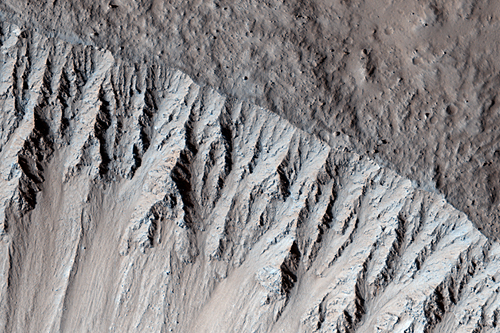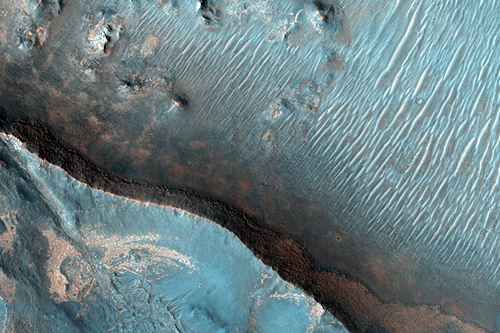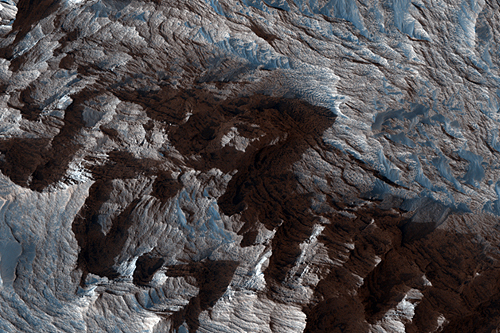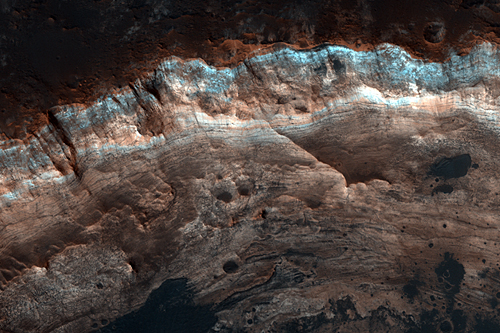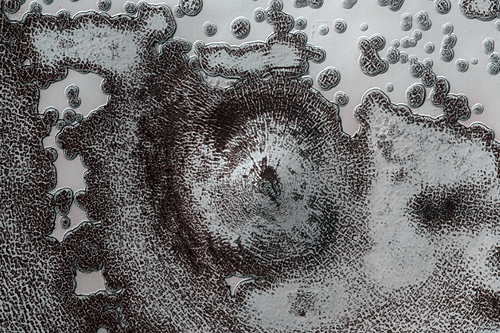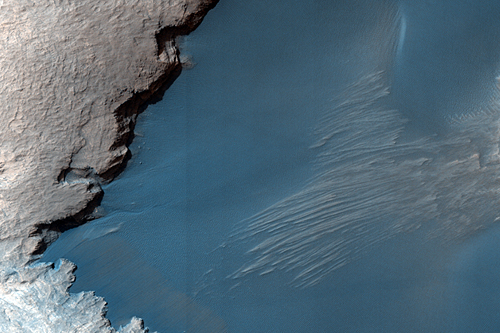A Fresh, Lunar-Like Crater on Mars (ESP_020077_1915)
This image is of an approximately 5 kilometer (approx. 3.1 mile) diameter crater that is one of the rare examples of a fresh "lunar-like" crater on Mars. The impact crater formed in the Tharsis region, which is the volcanic region on Mars that harbors the great Olympus Mons volcano -- in fact, this crater lies just 150 kilometer (94 miles) from the flanks of Olympus.
Now most really fresh craters on Mars typically have floors with a frothy, pitted deposit on them (see Zumba Crater caption), which possibly suggesting that water/ice was present in the subsurface prior to impact.
This 5 kilometer crater completely lacks such materials. Instead, the crater possess a deposit is generally smooth with some rocks peppered throughout the deposit. This is more similar to observations of fresh craters on the Moon. ...
Nili Fossae Trough, Candidate MSL Landing Site (PSP_003086_2015)
The Nili Fossae region of Mars is one of the largest exposures of clay minerals discovered by the OMEGA spectrometer on Mars Express and mapped in greater detail by the CRISM spectrometer on MRO (see the gallery).
In the HiRISE IRB color, dark blue regions are basaltic in composition, including sand-sized material that bounces around in the wind to form dunes. Basalt in the most common type of volcanic rock on the Earth and other terrestrial planets.
The light-toned areas (with a variety of colors) and covered by small-scale fractures is the clay-rich material. Clay minerals contain hydrogen and oxygen (i.e., water) within their mineral structure, and may also preserve organic materials, so there is great interest in studying these deposits to understand past environments that could have supported life. ...
Layered Bedrock in Candor Chasma (PSP_003830_1740)
This image shows an area of layered deposits in Candor Chasma. Here, sheets and dunes of dark-toned sand cover the light-toned, layered bedrock. Accumulations of dark sand accentuate bedding within the light-toned bedrock, giving some areas a zebra striped pattern.
In the Northern part of the scene, the bedrock has been eroded into steep, craggy cliffs. Some sections of these cliffs are covered by triangular-shaped debris fans that are intermediate in color between the dark-toned sand and light-toned bedrock.These fans may contain a mix of light-toned bedrock that has crumbled away from the surrounding cliffs and wind-blown sand and dust.
The surfaces of some fans are dissected by gullies, which most likely formed through dry avalanching. ...
Layers Exposed in Crater Near Mawrth Vallis (PSP_004052_2045)
This image covers an impact crater roughly 4 kilometers (2.5 miles) in diameter. The portion highlighted shows a one kilometer segment of the crater wall and rim.
The surface outside the crater is relatively dark, while the interior wall of the crater exposes lighter, layered bedrock of diverse colors. A few dark patches on the crater wall have small dunes or ripples on their surfaces, and are likely pits filled with dark sand. The crater provides a window into the subsurface of Mars, revealing layered sedimentary deposits.
Just 30 kilometers (20 miles) to the East of this crater lies Mawrth Vallis, an ancient channel that may have been carved by catastrophic floods. In layered deposits surrounding Mawrth Vallis, the orbiting spectrometers OMEGA (on Mars Express) and CRISM (on MRO) have detected phyllosilicate (clay) minerals, ...
Circular Feature in South Polar Residual Cap (PSP_005349_0930)
This 4 kilometer diameter feature near the edge of the South polar residual cap was recognized in Mariner 9 and Viking Orbiter images taken in the 1970s, but its origin could not be inferred. It was therefore targeted for HiRISE stereo imaging.
The bright areas in this image are covered by carbon dioxide frost, and the "swiss cheese" terrain typical of the south polar residual cap covers much of the imaged area. The dark walls of the circular depression do not have as much frost on them, and are fractured in a polygonal pattern. Apparently the surface of the walls has been extensively modified by thermal expansion and contraction of water ice.
It also appears that the "swiss cheese" terrain of the residual cap has buried the floor of the circular depression, as well as the terrain surrounding the feature, making it difficult to infer the origin of this depression. ...
Credit: NASA/JPL/University of ArizonaThumbprint Texture on Dark Dunes in Rabe Crater (PSP_005514_1360)
This image shows part of the floor of Rabe Crater, a large (108 kilometers, or 67 miles in diameter) impact crater in the Southern highlands.
Dark dunes—accumulations of wind blown sand—cover part of crater's floor, and contrast with the surrounding bright-colored outcrops. The extreme close-up view reveals a thumbprint-like texture of smaller ridges and troughs covering the surfaces of the larger dunes. These smaller ripples are also formed and shaped by blowing wind in the thin atmosphere of Mars.
One puzzling question is why the dunes are dark compared with the relative bright layered material contained within the crater. The probable answer is that the source of the dark sand is not local to this crater; rather, this topographic depression has acted as a sand trap that has collected material being transported by winds ...
<-- Previous HiRISE thread
Space Imagery Center | HiRISE 2011 Calendar
